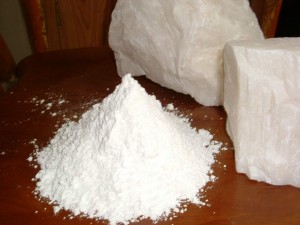

 It seems talc is the Rodney Dangerfield of industrial minerals. In 2010, when the US government decided to sell its defense stockpile of talc minerals, there were no buyers. It’s still sitting there.
It seems talc is the Rodney Dangerfield of industrial minerals. In 2010, when the US government decided to sell its defense stockpile of talc minerals, there were no buyers. It’s still sitting there.
Let’s face it; it’s hard to take a mineral seriously when most people associate it with powdering babies’ bottoms. Yet, talcum powder is responsible for less than 1% of talc’s demand.
Talc is critical to the paper industry. Talc is the major ingredient in paper brighteners that eliminate the yellow tinge in paper. It also makes ink transfer easier and reduces smearing. Talc can also add strength to the paper and, since it is soft, reduces wear on production and printing equipment.
The largest use for talc is in the paint industry. Although it acts as filler, it has several properties that make paint better. It makes paint more water resistant, which helps weathering with outside paint and makes interior paint easier to clean with water and a sponge. Larger talc particles also keep paint from cracking as easily.
Some of the same properties of talc in paint make it useful in the plastics industry. Talc increases the stiffness of polypropylene. It also prevents shrinkage in plastic parts when they are molded. Since it is acid resistant, it is used in some food containers like those used for yoghurt.
Since talc is soft and chemically inert, it is useful in the food industry. One common use is as that soft layer of white powder you find on chewing gum that prevents the gum from sticking to the paper.
It’s also critical in olive oil production. Olives are washed, pressed and then ground into a paste. Water is then added, and the solid matter is separated from the oil and water in a centrifuge. After a while, the oil that separates from the water is skimmed off and bottled. Unfortunately, some olives make the process harder either because the weather at harvesting was bad or they were picked too early or late. When crushed, they release fine solid particles that act as an emulsifier as they tend to bind the olive oil with the water. However, talc adsorbs the emulsifier particles and helps smaller oil droplets to form larger drops that are easier to centrifuge.
Since talc has no known allergenic or irritation reactions, it is also used in medicines, makeup, and of course, talcum powder. It has a mild disinfectant and anti-itching effect. It is also used as an inactive ingredient in pharmaceutical powders.
Fortunately talc is one industrial mineral that the United States produces domestically. America is the second largest producer of talc, while China is the largest. The largest talc formations in America are in Montana, but they range from New York State to California. Most of the talc comes from open pit mines where it is drilled, blasted and crushed on site. It then usually goes to the mill where it is chemically analyzed and stored in a warehouse. It is then ground to a fine powder and run through floatation tanks in order to remove impurities. The slurry is then thickened and dried out before it is turned into one of dozens of final products that have differing particle size, brightness, chemical composition, and density.
Talc is also used in ceramics, which is a boon for the American Talc Company’s talc mine near Van Horn, Texas. Being located near low cost natural gas deposits means that ceramic tiles are cheaper to produce there than at other mining locations. Given its use in tiles, paints, and roofing, it’s easy to see how the demand for talc is directly related to construction activity.
Talc also acts as a high temperature insulator for electricity, which is why it was once considered a critical industrial mineral worth stockpiling for defense purposes. Vacuum tubes contained talc minerals to act as an insulator and to dissipate heat. No wonder the demand for the government’s talc is so low. However, vacuum tubes still find a place in high power radio frequency broadcasting.
That’s a lot of uses for a mineral that gets so little respect.